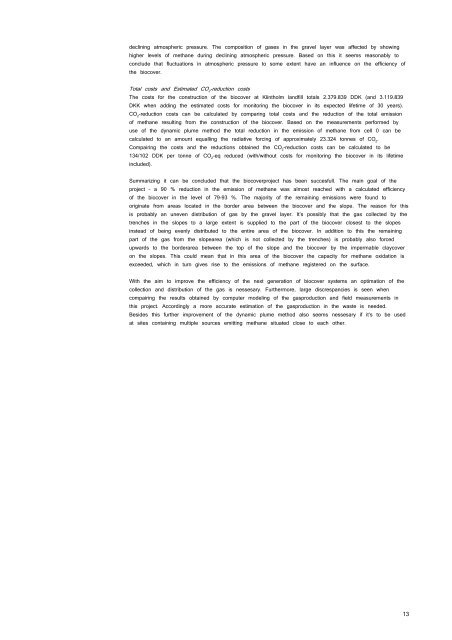Publishers version - DTU Orbit - Danmarks Tekniske Universitet
Publishers version - DTU Orbit - Danmarks Tekniske Universitet
Publishers version - DTU Orbit - Danmarks Tekniske Universitet
- No tags were found...
Create successful ePaper yourself
Turn your PDF publications into a flip-book with our unique Google optimized e-Paper software.
declining atmospheric pressure. The composition of gases in the gravel layer was affected by showinghigher levels of methane during declining atmospheric pressure. Based on this it seems reasonably toconclude that fluctuations in atmospheric pressure to some extent have an influence on the efficiency ofthe biocover.Total costs and Estimated CO 2 -reduction costsThe costs for the construction of the biocover at Klintholm landfill totals 2.379.839 DDK (and 3.119.839DKK when adding the estimated costs for monitoring the biocover in its expected lifetime of 30 years).CO 2 -reduction costs can be calculated by comparing total costs and the reduction of the total emissionof methane resulting from the construction of the biocover. Based on the measurements performed byuse of the dynamic plume method the total reduction in the emission of methane from cell 0 can becalculated to an amount equalling the radiative forcing of approximately 23.324 tonnes of CO 2 .Compairing the costs and the reductions obtained the CO 2 -reduction costs can be calculated to be134/102 DDK per tonne of CO 2 -eq reduced (with/without costs for monitoring the biocover in its lifetimeincluded).Summarizing it can be concluded that the biocoverproject has been succesfull. The main goal of theproject – a 90 % reduction in the emission of methane was almost reached with a calculated efficiencyof the biocover in the level of 79-93 %. The majority of the remaining emissions were found tooriginate from areas located in the border area between the biocover and the slope. The reason for thisis probably an uneven distribution of gas by the gravel layer. It’s possibly that the gas collected by thetrenches in the slopes to a large extent is supplied to the part of the biocover closest to the slopesinstead of being evenly distributed to the entire area of the biocover. In addition to this the remainingpart of the gas from the slopearea (which is not collected by the trenches) is probably also forcedupwards to the borderarea between the top of the slope and the biocover by the impermable claycoveron the slopes. This could mean that in this area of the biocover the capacity for methane oxidation isexceeded, which in turn gives rise to the emissions of methane registered on the surface.With the aim to improve the efficiency of the next generation of biocover systems an optimation of thecollection and distribution of the gas is nessesary. Furthermore, large discrespancies is seen whencompairing the results obtained by computer modeling of the gasproduction and field measurements inthis project. Accordingly a more accurate estimation of the gasproduction in the waste is needed.Besides this further improvement of the dynamic plume method also seems nessesary if it’s to be usedat sites containing multiple sources emitting methane situated close to each other.13
















